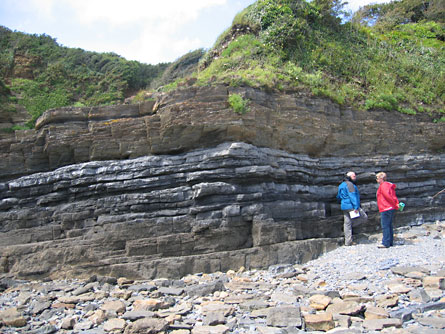Normal 0 false false false MicrosoftInternetExplorer4 For the first time, researchers have assembled a comprehensive record of sea level variations during the Paleozoic Era, producing a nearly-300-million–year timeline that more than doubles previous chronicles for such fluctuations.
Many of the variations, some as much as 100 meters, could have been caused by geological processes other than the formation of massive, land-based ice sheets, the scientists speculate in the Oct. 3 Science.

The geological record is replete with evidence of rising and falling sea levels, such as the interleaving, or alternating, of rock layers derived from soil with those composed of ancient marine sediments. Determining the age of such a rock formation provides a snapshot of where sea level sat when the layers were deposited, says Bilal Haq, a marine geologist at the National Science Foundation in Arlington, Va.
Until now, however, no one had pieced together those snapshots to make a kind of movie that tracked ancient sea level through what scientists call the Paleozoic Era. That interval extends from about 542 million years ago, the beginning of the Cambrian Period — an era that saw life’s diversity proliferate — until the end of the Permian Period about 251 million years ago, when Earth suffered one of its largest mass extinctions (SN: 2/1/97, p. 74).
Haq and colleague Stephen Schutter, a geologist with Murphy Oil Corporation in Houston, analyzed data gathered worldwide by numerous teams in dozens of previous field studies. Some of the data were gleaned from core samples drilled during oil exploration. Most of the age estimates derive from the analysis of fossils in those strata — a technique that sometimes can be relatively imprecise — but some of the older rock formations were dated using geochemical techniques. In all, the researchers identified 172 changes in sea level during the 291-million–year interval. For much of that period, sea levels were well below where they are today.
About 542 million years ago, global sea level sat about 40 meters below today’s benchmark, Haq and Schutter estimate. During the 95 million years that followed, short-term variations in sea level — some as much as 80 meters, some as little as 20 — occurred within a steady decline in sea level, which ultimately dropped to about 240 meters below where it sits today. By 320 million years ago, sea level rebounded to modern levels, but then fell 100 meters before recovering to end the Paleozoic Era about 10 meters higher than the sea sits today.
Scientists have discovered evidence of widespread glaciation for only about 28 percent of the Paleozoic, and they suspect ice sheets may have existed during another 10 percent of the time, says Haq. Much of the evidence for widespread glaciation may have eroded away. Nevertheless, he notes, fluctuation in ice sheets can’t be considered the only cause for variations in global sea level.
The expansion and contraction of ice sheets offer a relatively quick way for sea level to vary. During the height of the last ice age, about 40,000 years ago, sea level was at least 100 meters below where it is today. However, what caused major changes in sea level during the Paleozoic, especially during periods for which there are no known glaciations, “is one of the big unknowns in geology,” says Jim Ogg, a geologist at PurdueUniversity in West Lafayette, Ind.
Over the long term, changes in tectonic activity also influence sea level, says Haq. As ocean crust ages, it becomes more dense and tends to weigh down the underlying mantle — a process that makes the oceans deeper and causes sea levels to drop. Recent studies indicate that during the next 80 million years, sea level will drop between 70 and 120 meters, depending on whether today’s ice sheets melt completely (SN: 3/8/08, p. 150). Unfortunately, most of the ocean crust that formed during the period studied by Haq and Schutter has been recycled by tectonic activity, so researchers can’t easily estimate the average age of ocean crust at various times during that period.






